Uncategorized
Campaign Exceeded Goal by More Than $5 Million
WASHINGTON, D.C.(Feb. 4, 2016) – The Land Trust Alliance, a national land conservation organization working to save the places people love by strengthening land conservation across America, today announced the completion of its first campaign, which raised $40.1 million in new funds. The total is more than $5 million above the campaign goal.
“It’s of course a wonderful thing to celebrate the fact that we overshot our goal by over $5 million,” said Frederic Rich, campaign co-chair and vice chair of the Alliance’s board of directors. “Forty million dollars is an impressive achievement for an organization of this size. But frankly, it’s not the money that matters. It’s what we were able to do with this money.”
Used to increase the pace, improve the quality and ensure the permanence of land conservation, campaign funds were reinvested as they were received across five years. The resulting initiatives – such as making permanent a federal tax incentive for land conservation and establishing the Terrafirma Risk Retention Group – have transformed the entire land trust community.
“The title of this campaign was Together: A Campaign for the Land,” Rich said. “The Alliance itself is all about having the nation’s 1,700 land trusts think of themselves as together in a single, national movement. Every land trust itself is all about a community coming together to save the places that define them. And those places that we save, those are places where people come together and where their differences seem trivial. So if you ask me how we succeeded in this campaign, the answer is absolutely the same: We succeeded because we did it together.”
Leaders of land trusts across the United States already appreciate the differences the campaign has made. Nicole Byrd, executive director of Solano Land Trust in California, said the Alliance “invests in all of us and they are genuinely invested in our success.” And Christine Johnson, president of the Conservation Foundation of the Gulf Coast in Florida, described the Alliance as her “go-to place for making sure that I am doing all that I can to save the land we cherish so much.”
For more information about how the Alliance is helping land trusts save the places people need and love, visit www.landtrustalliance.org.
Campaign leaders included: David H. Anderson, honorary chair; Michael P. Dowling, campaign co-chair; and Frederic C. Rich, campaign co-chair. The campaign cabinet included: Robert A. Ayres; Alan M. Bell; Lauren B. Dachs, campaign vice-chair; Peter O. Hausmann, chair of the National Council; Sherry F. Huber, campaign vice-chair of regional committees; Ted Ladd, campaign vice-chair; and William Mulligan.
Regional campaign committees included chair Ted Ladd, Lisa Cashdan, Scott Dickerson, Jameson S. French, Sherry F. Huber, Laura A. Johnson, Mary McFadden, J.D., Nicholas J. Moore, Julie Sharpe, Steve Small and Peter Stein for the New England region; co-chairs Peter O. Hausmann and Frederic C. Rich, Christopher E. Buck, Marjorie L. Hart, Alice E. Hausmann, Tony Kiser, Fernando Lloveras San Miguel, Caroline P. Niemczyk and Michael A. Polemis for the New York/Mid-Atlantic/Puerto Rico region; co-chairs Alan M. Bell and William Mulligan, David Hartwell, Kathy K. Leavenworth and Judith Stockdale for the Midwest region; chair Lauren B. Dachs, Maria Elena Campisteguy, Anne Kroeker, Glenn Lamb, Richard Leeds, Thomas S. Reeve and Darrell Wood for the Pacific region; and co-chairs David H. Anderson and Robert A. Ayres, Lise H. Aangeenbrug, Laurie Andrews, Michael P. Dowling, Lawrence R. Kueter, Penelope H. Lewis and George S. Olsen for the Rocky Mountain/Texas region.
About the Land Trust Alliance
Founded in 1982, the Land Trust Alliance is a national land conservation organization that works to save the places people love by strengthening land conservation across America. The Alliance represents more than 1,100 member land trusts supported by more than 100,000 volunteers and 5 million members nationwide. The Alliance is based in Washington, D.C. and operates several regional offices. More information about the Alliance is available at www.landtrustalliance.org.
Uncategorized
In-line ramming tool cradle maximizes energy transfer in pipe ramming extraction technique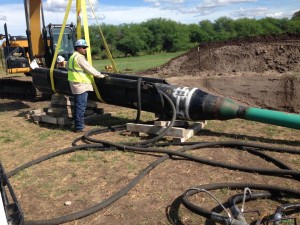
January 28, 2016 – LAKE MILLS, Wisc.– Pipe ramming tools from HammerHead Trenchless Equipment can now be locked inside a wide range of ready-made extraction cradles manufactured by the company. The extraction cradles, sometimes referred to as “canoes,” enable horizontal direction drilling (HDD) contractors to orient a ramming tool 180 degrees to extract stuck pipe or tooling, assist in product pullback and remove washover casing at the end of the HDD job. Extraction cradles also give pipeline installers the most effective means to slick bore and install cathodic protection (CP) pipe.
Unlike fabricated offset mounts that lose a significant portion of ramming energy laterally, an extraction cradle is mounted directly in line with the pipe or tooling. This alignment transfers impact force from the ramming tool to the pipe or HDD tooling with maximum efficiency.
Compared to other mounting methods, using an extraction cradle means more work gets done, while eliminating time and labor – hours, sometimes days – of fabricating a mounting system.
Alan Goodman, a Global Sales Manager for HammerHead Trenchless Equipment, said the ready-made extraction cradles are reusable and highly versatile. A single cradle can also accommodate a range of both pipe and hammer sizes.
“For instance our 36-inch extraction cradle can mount to 36-inch casing on one end and a 30-inch casing on the other end,” Goodman said. “Then it can be modified further to address other casing sizes by using standard pipe reducers. This means the same cradles can be used with our 26-inch, 24- or 20-inch hammers.”
Slick boring pipeline
One of the most exciting uses of the extraction cradle is in a trenchless pipeline installation method called “slick boring,” an effective, safe method of installing pipeline products, which are routinely protected by a coating supplemented with cathodic protection (CP). A CP system protects a wide variety of metallic structures from corrosion in various environments unless it is compromised.
To install a coated-lined pipe with a pipe ramming tool, a slick bore contractor simply drives a sacrificial, standard casing as a “dummy” into the ground with conventional pipe ramming technique. The contractor removes the ramming tool to place it in the extraction cradle, which has been mounted at the other end of the pipe.
The contractor welds the new coated-lined pipe to the dummy casing that was initially rammed into place. As the hammer locked inside of the cradle extracts the dummy casing from the ground, the dummy casing pulls the coated-lined pipe into place. Slick-boring method limits stress or damage to the pipe or its coating, since they are never subjected to direct impacts from the hammer. The dummy casing, which takes the brunt of the impact force as the casing cuts and drives the casing forward, can often be reused for additional slick boring jobs.
HDD completion insurance
Having an extraction cradle and hammer on hand during challenging HDD operations helps to assure the contractor of completion. “Stuck pipe or tooling is an urgent situation,” Goodman said. “Since there is little fabrication or welding needed, the contractor begins efforts to save the bore, pipe, or tool string as quickly as possible.”
Minutes make the difference in such cases, Goodman said. “There’s no 100 percent guarantee that ramming a stuck pipe or drill stem will save a job. While it’s definitely the best technique available for getting them moving again, the chances of saving the bore hole and freeing pipe or tooling go down with the length of time they remain in the ground. If the contractor doesn’t have a standby extraction cradle and hammer, HammerHead Trenchless Equipment will rush one of each to the site immediately upon getting the call for help. We can also have a technician there on site with them.”
Removing washover casing
HDD contractors drive washover casing to reach more favorable drilling conditions, isolate drilling operations from the formation, protect circulation, and ensure maximum recovery of fluids. Pipe ramming tools mounted in extraction cradles are an effective means of extracting the washover casings at the end of the job.
The HammerHead Trenchless Equipment extraction cradle comes in a variety of sizes and is available from HammerHead Trenchless Equipment or from authorized dealers, worldwide. Authorized dealers can be found on the web at www.hammerheadtrenchless.com or by calling 800.331.6653. (International: + [1] 920.648.4848).
Uncategorized
Pro-liner glass reinforced ultraviolet light cured trenchless pipe liners
February 2, 2016, San Diego, CA – The Monte Vista Group, LLC (MVG) today announced the implementation of the largest, most advanced facility in China for the manufacture of ultraviolet light cured-in-place pipe (UVCIPP) technology. The facility is owned and operated by Beijing Pro-liner Pipetech Co., Ltd., (Pro-liner), a wholly owned subsidiary of Beijing Longkexing Trenchless Engineering Co., Ltd., (http://www.longkexing.com). Pro-liner is the first Chinese-made ultraviolet light cured glass reinforced pipe liner for the trenchless rehabilitation of sewer and storm water pipes in China. The announcement coincides with the beginning of commercial production of liner for sale to the Chinese as well as to other international municipal contractor markets. “After several years of developing the market for UVCIPP in China, we investigated several different products worldwide to manufacture in China. We chose MVG due to their advanced technology, their experience in the industry, and their unique business strategy of building manufacturing facilities for companies like ours who want to make and brand their own technology,” said Mr. Fueshen Wu, President of Pro-liner. “A new facility has been under construction for the past 12 months and now we have begun the manufacturing of the most advanced technology in the world for producing one of the strongest and fasted curing UVCIPP liners anywhere,” said Mr. Yaugfhen Wang, Vice President of Engineering for Pro-liner.
“We are excited to bring our high quality, high strength product to China for the rehabilitation of their underground infrastructure. MVG has been committed to offering the most advanced technology to the trenchless market. We are taking the UVCIPP market to a new level of performance in the products that we license and how the information about those products is shared throughout the entire supply chain with our unique software platform,” said Richard Montemarano, Managing Director of the Monte Vista Group, LLC.
The new Pro-liner product is manufactured in sizes from 150MM to 1500MM in diameter and various thicknesses to meet the high standards required by the Chinese market. In addition, new test results reflect a 30 percent increase in strength over any of the current leading international competitors. “This new technology is the result of my 25 years of experience in developing UV cured glass liners,” said Rene Quitter, Director of Technology for the Monte Vista Group, LLC. “Our company is very excited to be working with the people at Pro-liner. Their focus on quality and on their customers was key for our mutual cooperation.”
The full production of liners began at the end of January and is already attracting the attention of the entire Pacific Rim trenchless community, as well as other international customers.
Beijing Pro-liner Pipetech Co., Ltd., is a wholly owned subsidiary of Beijing Longkexing Trenchless Engineering Co., Ltd. (http://www.longkexing.com). The company provides services within the trenchless industry, including pipeline monitoring, survey, diagnosis and evaluation, trenchless pipeline installation and rehabilitation, pipeline repair and maintenance, and all other services related to underground construction. The company has been a major installer of UVCIPP lining technology for the past five years, leading the Chinese trenchless market in installations and clients.
The Monte Vista Group, LLC (MVG) is a California LLC specializing in the building and licensing of UVCIPP technology for U.S. and international markets. The company employs a highly specialized team of engineers and trenchless experts who bring the MVG technology to large trenchless contractors and other industries whose objective is to build their own lining products for the UVCIPP markets. For more information contact The Monte Vista Group, LLC at 619-972-6277 or visit www.montevistagroup.com.
Uncategorized
ATLANTA – For the third year in a row, the U.S. Environmental Protection Agency (EPA) is accepting nominations for the Rain Catcher Awards for excellence in implementation of stormwater green infrastructure projects during the past year. Award categories are available for Municipal, Commercial, Tribal, and Neighborhood/Community levels.
Nominations are due to the agency by March 18, 2016. The awardees will be honored at a ceremony in Nashville, TN on May 17, 2016.
For award criteria and nomination instructions, visit the About EPA Region 4 web page at: http://www.epa.gov/ga/epa-region-4s-rain-catcher-awards.
The EPA Region 4 Rain Catcher Award recognizes excellence in the implementation of stormwater green infrastructure practices. Green infrastructure uses natural systems and/or engineered systems designed to mimic natural processes to more effectively manage urban stormwater and reduce receiving water impacts. EPA and its partner organizations have promoted the use of green infrastructure for many years as part of a comprehensive approach to achieving healthier waters. Green infrastructure reduces the volume of stormwater discharges by managing rainwater close to where it falls and removes many of the pollutants present in runoff, making it an effective strategy for addressing wet weather pollution and improving water quality.
Connect with EPA Region 4 on Facebook: www.facebook.com/eparegion4.
Uncategorized
PELLA, Iowa — Vermeer Corporation announced the appointment of Robert Hund and Scott Nelson to its board of directors. Both are veteran corporate executives within the industrial equipment manufacturing industry.
“Robert and Scott bring a wealth of proven business and manufacturing leadership experience to our board,” said Jason Andringa, president and CEO of Vermeer. “Both bring strong skills in strategic thinking and financial management to our company.”
The Vermeer board is composed of world-class executives who serve as outside independent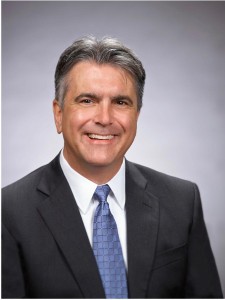 directors. These directors help bring an operational excellence mindset, a global perspective and relevant cross-functional experience to the Vermeer global agricultural and industrial equipment business.
directors. These directors help bring an operational excellence mindset, a global perspective and relevant cross-functional experience to the Vermeer global agricultural and industrial equipment business.
Hund most recently was the president of Manitowoc Foodservice, a leadingcommercial kitchen equipment manufacturer. He has also held marketing and product development executive level positions with Manitowoc Cranes and led product development for the mining and construction equipment division of Caterpillar, Inc.
“Robert brings vast international and product development experience to our board of directors,” said Mary Andringa, chair of the board for Vermeer. “He has a strong record in growing opportunities via new product development, innovation and improving distribution channels on multiple continents.”
As president of Sullair LLC — an industry leading global manufacturer of compressed air solutions — Nelson leads the company’s product development, manufacturing and worldwide distribution network. He has also held executive-level positions with Doosan Infracore Construction Equipment, Doosan Infracore International and Ingersoll Rand/Bobcat Division.
“Scott has a strong global industrial equipment manufacturing and business management background,” said Mary Andringa. “We are excited that he will be joining the Vermeer board.”
For more information visit vermeer.com.
Vermeer Corporation delivers a real impact in a progressing world through the manufacture of high-quality underground construction, surface mining, tree care, environmental and agricultural equipment. With a reputation for durability and reliability, that equipment is backed by localized customer service and support provided by independent dealers around
the world. To learn about Vermeer Corporation, products, the dealer network and financing options, visit
vermeer.com.
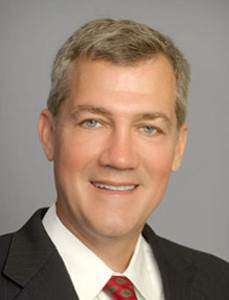
Vermeer, the Vermeer logo and Equipped to Do More are trademarks of Vermeer Manufacturing Company in the U.S. and/or other countries.
© 2016 Vermeer Corporation
All Rights Reserved.
Please send all reader inquiries to:
Vermeer Corporation
1210 Vermeer Road East
Pella, Iowa 50219
+1-641-628-3141
Uncategorized
Fairpoint Regional Utility System is a regional water supply entity located east of Pensacola, 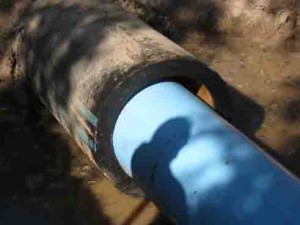 Florida in southern Santa Rosa County. The utility supplies potable water to several local water supply systems, including the City of Gulf Breeze, Holley-Navarre, Navarre Beach, and Midway. Fairpoint Regional Utility’s system consists of seven aquifer supply wells located east of Milton and approximately 23 miles of water transmission mains conveying treated, potable water to the various coastal service areas. The transmission system was installed and placed into service in 2004.
Florida in southern Santa Rosa County. The utility supplies potable water to several local water supply systems, including the City of Gulf Breeze, Holley-Navarre, Navarre Beach, and Midway. Fairpoint Regional Utility’s system consists of seven aquifer supply wells located east of Milton and approximately 23 miles of water transmission mains conveying treated, potable water to the various coastal service areas. The transmission system was installed and placed into service in 2004.
A key segment of the transmission main is a 2,800 foot crossing under the East Bay. This section of the line was originally installed via horizontal directional drilling (HDD) using 30-inch DR9 DIPS HDPE pipe (32-inch OD, 24.5-inch ID). In the spring of 2014 the HDPE crossing was determined to be leaking and was taken out of service for inspection. A video of the interior of the pipeline revealed a gradual, spiraling, longitudinal crack 13 feet in length. Based on the original bore profile, the location of the crack was determined to start 408 feet from the south side of the bore at a depth of approximately 55 feet below the bottom of East Bay.
Ric Delp, Project Manager with Baskerville-Donovan, Inc., commented: “The cause of the failure is currently unknown. However, this is the second reported failure on an HDPE bore crossing in the system.” In May 2014, an RFP was issued for the repair of the main. Two repair options were solicited, including: 1) a point repair of the failure area, and 2) a complete slipline of the 2,800 foot crossing using a new pipe. Two proposals were received, with both contractors proposing to slipline the entire bore section with a new, structurally independent pipe. Fairpoint reviewed the proposals and selected T.B. Landmark to slipline the failed line with 20-inch DR18 DIPS Fusible C-905® PVC pipe.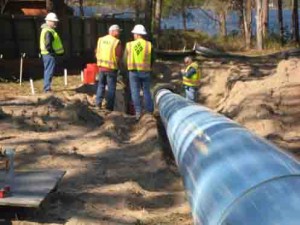
T.B. Landmark’s project plan called for mobilization of a horizontal directional drill rig to push a 22-inch rod ball through the existing 30-inch line to proof the pipe. The drill rig was set up on the north end of the bore alignment. Proofing of the existing pipe went smoothly and was completed in a single day.
An internal pull head was used to connect the drill stem to the Fusible PVC® pipe string. Due to space limitations on the south side of the bore alignment, the pipe string was fused and pulled into the host pipe in 45-foot sections in a “fuse-and-pull” installation. Pull forces during installation never exceeded 17,000 lbs. The installation of the 2,800 foot pipe string required seven days to complete. According to Marty Adams of T.B. Landmark, “The pull forces required to install the pipe were significantly less than we anticipated.” After completion of pipe installation, the new line was flushed and pressure tested at 150 psi for two hours.
Following the pressure test, the line was disinfected and tested. Utility Services Company of Gulf Breeze, Florida made the final connections and tie-ins to place the transmission main back into service. Phil Phillips of Municipal Engineering Services, Inc., Fairpoint’s outside engineer, commented, “The ability to slipline this existing sub-aqueous bore with Fusible PVC® pipe enabled Fairpoint Utility System to rehabilitate the asset while maximizing the transmission main’s hydraulic 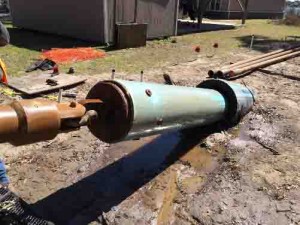 capacity.”
capacity.”
Images:
1 – 20” Fusible PVC® Pipe Entering 30” Host Pipe
2 – Fused Sections of New 20” Pipe
3 – Pull Head and Fusible PVC® Pipe Exiting Host Pipe
Uncategorized
Robust Rock Machine completes long-awaited water tunnel in Montreal
In a large November 2015 ceremony attended by the mayor of Montreal, Quebec, Canada, 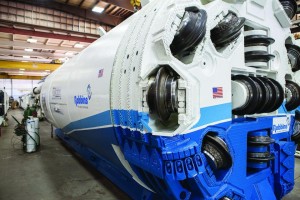 and representatives from local media outlets, the Rosemont Reservoir tunnel construction came to a close. The long-awaited project, more than 38 years in the making, gave good cause for celebration as crew members crowded around the cutterhead of the 3.0 m (9.8 ft) diameter Double Shield TBM that had emerged into an exit shaft.
and representatives from local media outlets, the Rosemont Reservoir tunnel construction came to a close. The long-awaited project, more than 38 years in the making, gave good cause for celebration as crew members crowded around the cutterhead of the 3.0 m (9.8 ft) diameter Double Shield TBM that had emerged into an exit shaft.
Local contractor Foraction, Inc., headed the excavation of the 4.0 km (2.5 mi) long tunnel with a TBM launch in December 2014. Roger Lepinay, Equipment Manager for Foraction, Inc., praised the Robbins disc cutter wear in both limestone and harder rock formations: “I was impressed by the cutters, it was a nice surprise. They were quite long-lasting compared to other cutters I have used on jobs in the past.”
Lepinay characterized the ground as “almost ideal”, with a few difficult sections. “Below 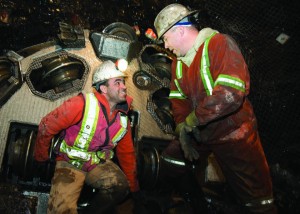 Montreal there is mostly thinly bedded limestone, with some shale and intrusive igneous dykes,” explained project geologist Brigitte Gagné for company Exp Service Inc. While the limestone averaged 100-150 MPa UCS, rock in the intrusives ranged from 100-300 MPa. The dykes were as small as 1 m (3.3 ft) wide and as large as 100 m (328 ft). The contractor was able to successfully navigate these sections despite the varying rock strengths. Even with geologic challenges including some water inflows and over-break in small sections, the contractor was able to achieve advance rates of up to 38 m (125 ft) per day in two shifts of 9.5 hours each. Much of the ground was self-supporting, though the contractor installed rock bolts every 2.5 m (8.2 ft) into portions of the tunnel crown, while mesh, rock bolts, and steel sheets were used in the sections of unstable rock.
Montreal there is mostly thinly bedded limestone, with some shale and intrusive igneous dykes,” explained project geologist Brigitte Gagné for company Exp Service Inc. While the limestone averaged 100-150 MPa UCS, rock in the intrusives ranged from 100-300 MPa. The dykes were as small as 1 m (3.3 ft) wide and as large as 100 m (328 ft). The contractor was able to successfully navigate these sections despite the varying rock strengths. Even with geologic challenges including some water inflows and over-break in small sections, the contractor was able to achieve advance rates of up to 38 m (125 ft) per day in two shifts of 9.5 hours each. Much of the ground was self-supporting, though the contractor installed rock bolts every 2.5 m (8.2 ft) into portions of the tunnel crown, while mesh, rock bolts, and steel sheets were used in the sections of unstable rock.
The long tunnel drive at small diameter was carefully planned to optimize logistics. The 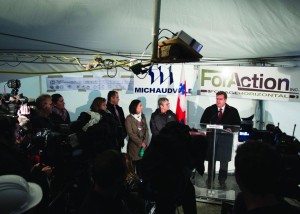 contractor utilized a muck train that could accommodate two pushes worth of excavated material. The first kilometer (0.6 mi) was ventilated from the launch shaft, while three surface-driven 800 mm (32 in) diameter surveying wells at the 1, 2, and 3 km (0.6, 1.2, and 1.9 mi) marks ventilated the rest of the tunnel as the TBM progressed.
contractor utilized a muck train that could accommodate two pushes worth of excavated material. The first kilometer (0.6 mi) was ventilated from the launch shaft, while three surface-driven 800 mm (32 in) diameter surveying wells at the 1, 2, and 3 km (0.6, 1.2, and 1.9 mi) marks ventilated the rest of the tunnel as the TBM progressed.
With the breakthrough, an important phase of the Rosemont Reservoir project is complete. The reservoir itself was built in 1960 to increase water supply to the city and a geotechnical study for the tunnel was carried out in 1977. However, other major infrastructure projects soon took priority and the project was placed on hold. By 2010, the population of the city had increased dramatically and problems with the existing reservoirs put the project back on the fast track. The large reservoir that sat idle for decades will now be used to improve much of the city’s water supply.
As of mid-January the contractor is working to ready the tunnel for installation of the carrier 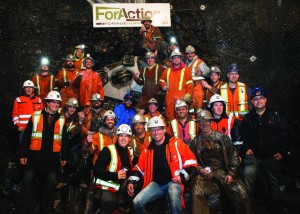 pipe, consisting of 2.13 m (84 in) I.D. pre-stressed concrete cylinder pipe (PCCP). Crews will then grout the pipe in place in preparation for the Rosemont Reservoir to come online.
pipe, consisting of 2.13 m (84 in) I.D. pre-stressed concrete cylinder pipe (PCCP). Crews will then grout the pipe in place in preparation for the Rosemont Reservoir to come online.
Image 1: The 3.0 m (9.8 ft) diameter Robbins Double Shield TBM bored a 4 km (2.5 mi) tunnel below downtown Montreal, Quebec, Canada.
Image 2: Workers climb through the cutterhead of the Robbins TBM to mark the breakthrough in November 2015 at a large ceremony.
Image 3: The mayor of Montreal, Denis Coderre, speaks to local media at the November ceremony for the Rosemont Reservoir tunnel breakthrough.
Image 4:The crew of Foraction, Inc. and Robbins gathers around the Double Shield TBM to celebrate the tunnel completion.
Uncategorized
GSSI, the world’s leading manufacturer of ground penetrating radar (GPR) equipment, will be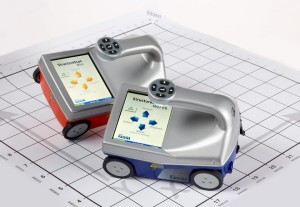 showcasing its latest GPR technology at the 2016 World of Concrete conference, to be held February 2-5, 2016, at the Las Vegas Convention Center in Las Vegas, Nevada, Booth # C4156. New technology to be featured includes the StructureScan Mini XT handheld GPR, as well as a 3D module for GSSI’s SIR® 4000 GPR control unit, which features numerous updates that support next-generation digital capabilities.
showcasing its latest GPR technology at the 2016 World of Concrete conference, to be held February 2-5, 2016, at the Las Vegas Convention Center in Las Vegas, Nevada, Booth # C4156. New technology to be featured includes the StructureScan Mini XT handheld GPR, as well as a 3D module for GSSI’s SIR® 4000 GPR control unit, which features numerous updates that support next-generation digital capabilities.
GSSI experts will be highlighting the new StructureScan Mini XThandheld GPR, the latest addition to the industry standard StructureScanall-in-one GPR system. Ideal for locating rebar, conduits, post-tension cables and voids, the StructureScan Mini is also used for real time determination of concrete slab thickness. Its compact design has long made the StructureScan Mini a favorite among concrete inspection professionals, especially in tight spaces or overhead survey locations. Drop by the booth to see the newest model, which features a friendly user interface and several new data collection modes. Additionally, the redesigned model is IP 65 rated- to withstand the jobsite’s toughest conditions.
Also on display will be the standard StructureScan Mini, whose 1600 MHz antenna can reach depths of up to 50 centimeters (20 inches).All the StructureScan Mini systems safely locate metallic and non-metallic targets, with an auto target feature that marks the features of interest. The systems are available with standard 2D capabilities, or with 3D capabilities for an x-ray-like image. The units’ ruggedized plastic casing and wheels ensure long-lasting performance.
The updated SIR 4000 GPR control unit on display features a variety of updates, including a new 3D functionality for Expert Mode that promises to revolutionize how three-dimensional GPR data is visualized, while simplifying an often complicated process. The controller’s innovative technology is compatible with both GSSI’s traditional analog antennas and newest digital offerings, resulting in the versatility and flexibility needed to support a wide range of users and applications.
The SIR 4000 updates also brings the StructureScan 2D and 3D collection modes to the controller, streamlining its use for the concrete construction industry. The module includes high frequency antenna-specific set-ups to ensure survey efficiency, and enables the controller to automatically recognize smart antenna set-ups. The updates also include an on-the-fly automatic gain option to better enhance the data display, while still saving the file in the original raw format for post processing. Also included is a horizontal zoom function that helps resolve smaller targets, and a “Save Image” shortcut for quick reports.
The updated SIR 4000 provides a 10.4 inch high definition display, a simple user interface, plug-and-play GPS integration, and multiple data transfer options. Designed with a number of exclusive features, the SIR 4000’s casted aluminum chassis offers superior temperature stability and an impact resistant design. The unit delivers a full IP 65 capability, and can withstand tough jobsite conditions.
Uncategorized
AURORA, IL. – TT Technologies recently introduced new downhole tooling for its Grundodrill 4X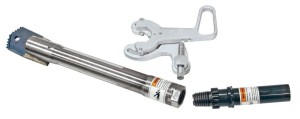 compact HDD rig. The new tooling improves safety and simplifies drilling operations by allowing users to quickly and safely disconnect the sonde housing segment from the drill string after the pilot bore is complete. The system is comprised of a specially designed sub saver and clamp that locks into place and allows the operator to easily and quickly disengage the sonde housing without the use of pipe wrenches.
compact HDD rig. The new tooling improves safety and simplifies drilling operations by allowing users to quickly and safely disconnect the sonde housing segment from the drill string after the pilot bore is complete. The system is comprised of a specially designed sub saver and clamp that locks into place and allows the operator to easily and quickly disengage the sonde housing without the use of pipe wrenches.
The compact Grundodrill 4X is designed for residential service, small diameter main installations and “last mile” operations, offering 9,800 lbs. of thrust and pullback. Using the compact drill is less intrusive and ideal for areas where larger units are not an option. The Grundodrill 4X also comes with the exclusive Smart Vice system that performs vice cycling operations automatically.
Uncategorized
District developing a long-range water plan to maximize assets
Broomfield, Colo., Jan. 13, 2016 – After a two-year study conducted by MWH Global and Hawksley Consulting, Castle Pines North Metropolitan District has decided on a long-range water plan that ensures the future of enduring water supplies to the District.
“The business of providing water to our residents in Castle Pines has become increasingly challenging. It’s not enough to own multiple water assets. We have to position ourselves in a way that gives us durable, sustainable and renewable water supplies to replace those from non-renewable groundwater sources,” said District Manager Jim Nikkel.
The District enlisted the help of Colorado-based engineering, consulting and construction firm MWH and its subsidiary, Hawksley Consulting for a study focusing on solutions that maximized the value and use of the District’s water assets. In addition, the firm determined a plan that reduces reliance on groundwater from wells and builds infrastructure to support a renewable water supply from snow and rainfall.
The District’s water plan was designed for strategic utilization of Lower South Platte water rights, Plum Creek and Hock Hocking water rights, as well as storage in Chatfield Reservoir. Nikkel said the plan achieves a meaningful goal.
“The plan we received from Hawksley Consulting will allow us to maximize our existing investments, replace up to 97 percent of our groundwater supplies, and cost us about half as much as we had originally estimated,” Nikkel said. He added, “In the first phase of the plan, we’ll have a renewable water supply of 900 acre-feet (AF) per year, or 50 percent renewable. This puts our community in a great position for our future water needs.”
Board President Keith Dodd, added, “Not just the current board, but previous boards have been diligent in working toward reducing our reliance on groundwater. Those sources aren’t always going to be enough for our community. We have a responsibility to protect what’s ours.”
Within the next three to five years, the initial phase of the District’s plan involves storage of renewable water in Chatfield Reservoir, through the Chatfield Reallocation Project. Nikkel says from that point, it will be a continual effort to bring assets on line.
“Our customers trust us to put the investment we’ve made to work. We’re doing that, by implementing the findings from Hawksley Consulting, developing the infrastructure, and continuing to assess our community’s long-range water needs,” Nikkel said.
About MWH Global
MWH Global is dedicated to Building a Better World. As specialists in water and natural resources, MWH employees use innovative ideas and technology to help solve complex infrastructure and environmental challenges. This work is built on a nearly 200-year history during which MWH has delivered services from initial planning and design through construction, start-up and operations. Today, MWH employs approximately 7,000 experts including engineers, consultants and construction professionals in 35 countries on six continents. Each of these experts is committed to serving global communities through sustainable development and project delivery. MWH is a private, employee-owned company headquartered in Broomfield, Colorado. For more information, visit www.mwhglobal.com or connect via Twitter, Facebook and LinkedIn.
About Hawksley Consulting
Hawksley Consulting builds on a rich legacy of innovation and impactful solutions to provide answers for our clients’ greatest challenges. Our management consultants throughout the U.S., U.K., Australia, New Zealand and the Middle East bring together global expertise in strategy, finance, risk management, asset management, organizational development, information technology, stakeholder engagement, and environmental and social sustainability. We implement practical solutions for public and private clients in the water, wastewater, energy, transportation, industrial and government sectors. Hawksley Consulting is a wholly-owned subsidiary of MWH Global, the leader in water and natural resources dedicated to Building a Better World. For more information, visit hawksley.com or connect with us on Twitter and LinkedIn.













